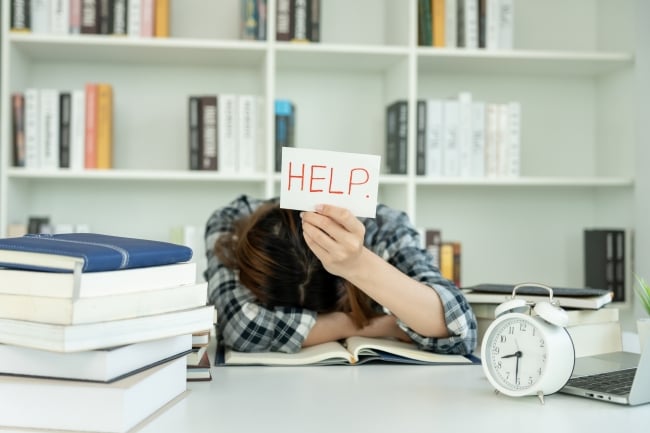You have /5 articles left.
Sign up for a free account or log in.

Nuttawan Jayawan/iStock/Getty Images Plus
In recent years, college faculty, staff and administrators have noticed a trend of more students who seem to need consistent guidance, support and feedback in their daily lives. Professors report that it is not uncommon to receive a volley of emails peppered with questions already addressed in class discussions. Advisers and counselors describe being inundated by learners who conflate small setbacks or inconveniences with significant academic and personal challenges. Faculty and staff are experiencing record levels of burnout and empathy fatigue and there are questions about how related this is to the increased needs of students.
It’s all too easy to resort to generalizations about this generation of students. But the rise of what psychologists call “learned helplessness” is driven by genuine mental health needs. For a variety of reasons—not the least of which was coming of age during the COVID-19 pandemic—students are increasingly overwhelmed. Research shows that learned helplessness is largely rooted in a loss of control, and it’s not difficult to understand why students might be feeling this way after spending their adolescent years witnessing intense societal turmoil.
Platform data from Uwill, the telehealth platform where I serve as director of clinical affairs, has found self-esteem issues, social isolation and trauma all rank among the most prevalent mental challenges students say they are struggling with. This combination of factors is leading students to lean more on trained professionals and dedicated resources than personal support systems. Institutions should take a proactive, sensitive approach to reducing students’ learned helplessness—working to address the underlying stressors at the heart of the phenomenon and empowering students to regain agency over their well-being.
Learned helplessness is directly connected to a larger mental health crisis taking place on college campuses. Institutions across the country are seeing record levels of depression and anxiety, with young adults reporting far greater levels of stress than older generations. About 60 percent of college students now report experiencing acute stress, while 56 percent say they are experiencing chronic stress. According to a survey released last year, 44 percent of students report experiencing depression, 37 percent report experiencing anxiety and 15 percent have seriously considered suicide. Addressing this challenge will require a nuanced understanding of the pressures and challenges students face today.
The unprecedented disruptions of the pandemic, a shift toward more anxious parenting styles, and a constant bombardment of stressors from social media have created a perfect storm for learners. A sense of helplessness surrounds them. Every day, they read alarmist headlines informing them they will soon be underemployed, underpaid and unable to ever afford a house or start a family. On social media platforms, many users do not calmly discuss the urgency of issues like climate change; they scream that the world is on fire. As the United Nations’ climate chief Jim Skea recently put it, apocalyptic language can “undermine a sense of agency" and lead people to assume a situation is hopeless, a feeling that can sap people of motivation.
The psychological toll of navigating this landscape is significant. However, there is a silver lining. Learned helplessness doesn’t only stem from societal tumult. After all, Gen Z is hardly the first generation to go to college during times of global uncertainty. The rise in learned helplessness is also rooted in a more positive trend: students are becoming far more proactive in seeking help from mental health professionals. And research shows that academic help-seeking behaviors are linked to improved academic performance and increased self-efficacy. The challenge for institutions is to assist students in decreasing learned helplessness behaviors while not inadvertently discouraging the inclination to seek help.
In recent years, colleges and universities have made great progress in destigmatizing mental health issues and in creating an environment where asking for help is not only accepted but encouraged. We don’t want to roll back that progress. But we can shift the conversation so that it focuses more on strength and resilience. Faculty, staff and counselors’ interactions with students should focus on providing learners with the scaffolding they need to develop their own problem-solving strategies rather than on offering prescriptive solutions. Students should leave these interactions having not only found an empathetic ear but a path forward that allows them to begin taking control of their mental health.
In moments of crisis, for instance, counselors can take a strengths-based approach that allows students to draw from their own experiences to identify how they can better support themselves through their current challenges. In therapy settings, therapists can work with learners to build safety plans, stress management plans and success plans that outline the tools and skills they can utilize to boost their mental health and wellness in moments of need outside of sessions. In all interactions, language is key, with practitioners framing conversations in a positive, asset-based manner. For example, shifting language like “presenting problem” to “current challenge’” helps the student acknowledge that the difficulties they are facing are transient and within their ability to improve.
The fact that earlier generations were less likely to seek help should not be a judgment about young people’s willingness to reach out now. Still, how we respond to their outstretched hands is critical. The goal is to build resilience, not foster dependency. Institutions can work to strike the right balance between support and empowerment, creating a generation of learners who are both self-reliant and unafraid to ask for help when they need it.




